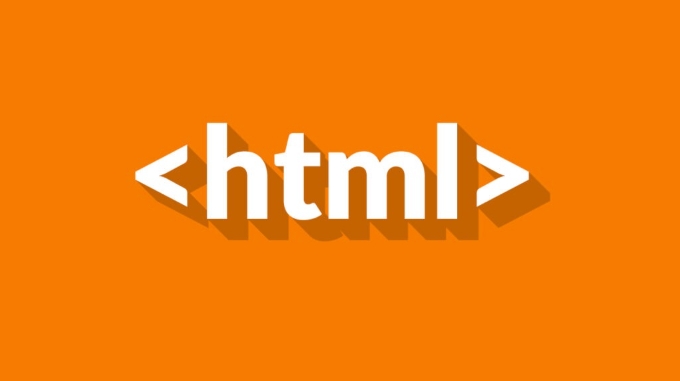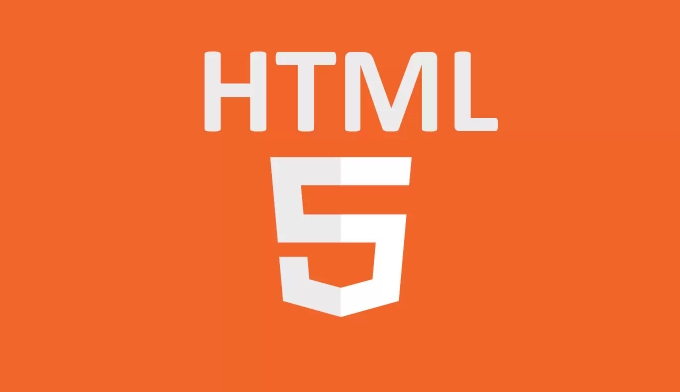It is not difficult to learn HTML5, it only takes four steps to get started. 1. HTML5 is a markup language used to define web page structure and content. It describes titles, paragraphs and image locations through tags such as
,
,  , etc., and adds semantic tags such as
, etc., and adds semantic tags such as

Want to learn HTML5? Actually it's not that difficult. HTML5 is the foundation of web page development. Even if you have zero foundation, you can quickly write your first web page by following the steps.

1. What is HTML5? First understand the basic concept
HTML5 is not a programming language, it is a markup language used to describe the structure and content of a web page. You can think of it as the skeleton of a web page - such as where the title is, where the paragraph is, where the pictures are placed, where the buttons are included, etc., are all defined through HTML.
Common tags include:

-
<h1></h1>to<h6></h6>: Title -
<p></p>: paragraph -
<a></a>: Link -
<img src="/static/imghw/default1.png" data-src="https://img.php.cn/upload/article/000/000/000/175251868684466.jpeg" class="lazy" alt="HTML5 tutorial for beginners" >: Picture -
<div> and <code><span></span>: Basic units of layout and styleThe advantage of HTML5 is that it has stronger semantics. New tags such as
<header></header>,<footer></footer>, and<article></article>can be seen at a glance and are more friendly to search engines.
2. How to start writing an HTML5 page?
Writing HTML5 does not require complicated tools, you can start by having a text editor (such as VS Code, Sublime Text or the simplest notepad).

A basic HTML5 page structure is as follows:
<!DOCTYPE html> <html lang="en"> <head> <meta charset="UTF-8"> <title>My first page</title> </head> <body> <h1>Welcome to my website</h1> <p>This is a paragraph. </p> </body> </html>A few explanations:
-
<!DOCTYPE html>Tell the browser that this is an HTML5 document -
<html>tags wrap the entire page content -
<head>puts metadata (not displayed on the page) -
<body>is the content area that the user actually sees
You can save this code as a
.htmlfile and open it in your browser to see the effect.3. Add common elements to make the page richer
After learning the basic structure, you can try to add some common elements to make your web page look more complete.
Pictures and links
<img src="/static/imghw/default1.png" data-src="image.jpg" class="lazy" alt="picture description"> <a href="https://example.com">Click here</a>
Notice:
-
srcis the image path, it is recommended to put it in the project folder -
altis an alternative text, important for SEO and accessibility - The link can point to other web pages or this website page
Form (user input)
<form> <label for="name">Your name:</label> <input type="text" id="name" name="name"><br><br> <input type="submit" value="submit"> </form>Forms are used to collect user information, such as registration, login and other scenarios.
Video and Audio (New HTML5 Features)
<video controls width="400"> <source src="movie.mp4" type="video/mp4"> Your browser does not support video playback. </video>This function used to be implemented using Flash, but now it is enough to use HTML5 directly.
4. Learn to check for errors, debugging is easier
It is inevitable to make mistakes when writing HTML, such as misspelling of tags, forgetting to close, wrong paths, etc. At this time, you can use the "developer tools" that comes with the browser to check.
How to operate:
- Right-click on the web page → “Check” or “Check Elements”
- View HTML structure under the Elements tag
- See if there is any red prompt or the label is not closed
You can also use online verification tools, such as W3C's HTML Validator, to help you find syntax problems.
Basically that's it. The learning curve of HTML5 is very smooth, the key is to write and practice more. At first, I might feel that I can’t remember the labels too much, but I will naturally become familiar with them if I use them too much. If you persist for a few days, you will be able to create your own web page.
-
The above is the detailed content of HTML5 tutorial for beginners. For more information, please follow other related articles on the PHP Chinese website!

Hot AI Tools

Undress AI Tool
Undress images for free

Undresser.AI Undress
AI-powered app for creating realistic nude photos

AI Clothes Remover
Online AI tool for removing clothes from photos.

Clothoff.io
AI clothes remover

Video Face Swap
Swap faces in any video effortlessly with our completely free AI face swap tool!

Hot Article

Hot Tools

Notepad++7.3.1
Easy-to-use and free code editor

SublimeText3 Chinese version
Chinese version, very easy to use

Zend Studio 13.0.1
Powerful PHP integrated development environment

Dreamweaver CS6
Visual web development tools

SublimeText3 Mac version
God-level code editing software (SublimeText3)

Hot Topics
 Adding drag and drop functionality using the HTML5 Drag and Drop API.
Jul 05, 2025 am 02:43 AM
Adding drag and drop functionality using the HTML5 Drag and Drop API.
Jul 05, 2025 am 02:43 AM
The way to add drag and drop functionality to a web page is to use HTML5's DragandDrop API, which is natively supported without additional libraries. The specific steps are as follows: 1. Set the element draggable="true" to enable drag; 2. Listen to dragstart, dragover, drop and dragend events; 3. Set data in dragstart, block default behavior in dragover, and handle logic in drop. In addition, element movement can be achieved through appendChild and file upload can be achieved through e.dataTransfer.files. Note: preventDefault must be called
 Handling reconnections and errors with HTML5 Server-Sent Events.
Jul 03, 2025 am 02:28 AM
Handling reconnections and errors with HTML5 Server-Sent Events.
Jul 03, 2025 am 02:28 AM
When using HTML5SSE, the methods to deal with reconnection and errors include: 1. Understand the default reconnection mechanism. EventSource retrys 3 seconds after the connection is interrupted by default. You can customize the interval through the retry field; 2. Listen to the error event to deal with connection failure or parsing errors, distinguish error types and execute corresponding logic, such as network problems relying on automatic reconnection, server errors manually delay reconnection, and authentication failure refresh token; 3. Actively control the reconnection logic, such as manually closing and rebuilding the connection, setting the maximum number of retry times, combining navigator.onLine to judge network status to optimize the retry strategy. These measures can improve application stability and user experience.
 Getting user location with HTML5 geolocation API
Jul 04, 2025 am 02:03 AM
Getting user location with HTML5 geolocation API
Jul 04, 2025 am 02:03 AM
To call GeolocationAPI, you need to use the navigator.geolocation.getCurrentPosition() method, and pay attention to permissions, environment and configuration. First check whether the browser supports API, and then call getCurrentPosition to obtain location information; the user needs to authorize access to the location; the deployment environment should be HTTPS; the accuracy or timeout can be improved through configuration items; the mobile behavior may be limited by device settings; the error type can be identified through error.code and given corresponding prompts in the failed callback to improve user experience and functional stability.
 Understanding the autoplay policy changes affecting HTML5 video.
Jul 03, 2025 am 02:34 AM
Understanding the autoplay policy changes affecting HTML5 video.
Jul 03, 2025 am 02:34 AM
The core reason why browsers restrict the automatic playback of HTML5 videos is to improve the user experience and prevent unauthorized sound playback and resource consumption. The main strategies include: 1. When there is no user interaction, audio automatic playback is prohibited by default; 2. Allow mute automatic playback; 3. Audio videos must be played after the user clicks. The methods to achieve compatibility include: setting muted properties, mute first and then play in JS, and waiting for user interaction before playing. Browsers such as Chrome and Safari perform slightly differently on this strategy, but the overall trend is consistent. Developers can optimize the experience by first mute playback and provide an unmute button, monitoring user clicks, and handling playback exceptions. These restrictions are particularly strict on mobile devices, with the aim of avoiding unexpected traffic consumption and multiple videos
 Using ARIA attributes with HTML5 semantic elements for accessibility
Jul 07, 2025 am 02:54 AM
Using ARIA attributes with HTML5 semantic elements for accessibility
Jul 07, 2025 am 02:54 AM
The reason why ARIA and HTML5 semantic tags are needed is that although HTML5 semantic elements have accessibility meanings, ARIA can supplement semantics and enhance auxiliary technology recognition capabilities. For example, when legacy browsers lack support, components without native tags (such as modal boxes), and state updates need to be dynamically updated, ARIA provides finer granular control. HTML5 elements such as nav, main, aside correspond to ARIArole by default, and do not need to be added manually unless the default behavior needs to be overridden. The situations where ARIA should be added include: 1. Supplement the missing status information, such as using aria-expanded to represent the button expansion/collapse status; 2. Add semantic roles to non-semantic tags, such as using div role to implement tabs and match them
 Securing HTML5 web applications against common vulnerabilities
Jul 05, 2025 am 02:48 AM
Securing HTML5 web applications against common vulnerabilities
Jul 05, 2025 am 02:48 AM
The security risks of HTML5 applications need to be paid attention to in front-end development, mainly including XSS attacks, interface security and third-party library risks. 1. Prevent XSS: Escape user input, use textContent, CSP header, input verification, avoid eval() and direct execution of JSON; 2. Protect interface: Use CSRFToken, SameSiteCookie policies, request frequency limits, and sensitive information to encrypt transmission; 3. Secure use of third-party libraries: periodic audit dependencies, use stable versions, reduce external resources, enable SRI verification, ensure that security lines have been built from the early stage of development.
 Integrating CSS and JavaScript effectively with HTML5 structure.
Jul 12, 2025 am 03:01 AM
Integrating CSS and JavaScript effectively with HTML5 structure.
Jul 12, 2025 am 03:01 AM
HTML5, CSS and JavaScript should be efficiently combined with semantic tags, reasonable loading order and decoupling design. 1. Use HTML5 semantic tags, such as improving structural clarity and maintainability, which is conducive to SEO and barrier-free access; 2. CSS should be placed in, use external files and split by module to avoid inline styles and delayed loading problems; 3. JavaScript is recommended to be introduced in front, and use defer or async to load asynchronously to avoid blocking rendering; 4. Reduce strong dependence between the three, drive behavior through data-* attributes and class name control status, and improve collaboration efficiency through unified naming specifications. These methods can effectively optimize page performance and collaborate with teams.
 Declaring the correct HTML5 doctype for modern pages.
Jul 03, 2025 am 02:35 AM
Declaring the correct HTML5 doctype for modern pages.
Jul 03, 2025 am 02:35 AM
Doctype is a statement that tells the browser which HTML standard to use to parse the page. Modern web pages only need to be written at the beginning of the HTML file. Its function is to ensure that the browser renders the page in standard mode rather than weird mode, and must be located on the first line, with no spaces or comments in front of it; there is only one correct way to write it, and it is not recommended to use old versions or other variants; other such as charset, viewport, etc. should be placed in part.







